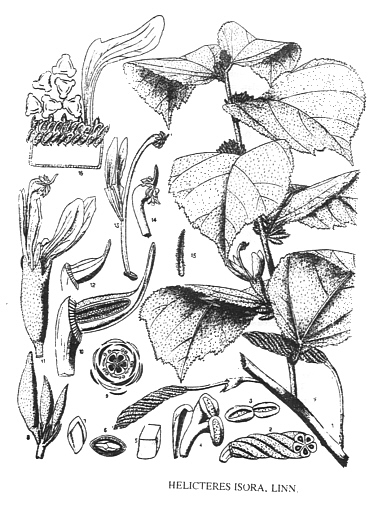

Zitierweise / cite as:
Carakasaṃhitā: Ausgewählte Texte aus der Carakasaṃhitā / übersetzt und erläutert von Alois Payer <1944 - >. -- Anhang A: Pflanzenbeschreibungen. -- Helicteres isora L. -- Fassung vom 2007-05-10. -- URL: http://www.payer.de/ayurveda/pflanzen/helicteres_isora.htm
Erstmals publiziert: 2007-03-19
Überarbeitungen: 2007-05-10
Anlass: Lehrveranstaltung SS 2007
©opyright: Dieser Text steht der Allgemeinheit zur Verfügung. Eine Verwertung in Publikationen, die über übliche Zitate hinausgeht, bedarf der ausdrücklichen Genehmigung des Verfassers
Dieser Text ist Teil der Abteilung Sanskrit von Tüpfli's Global Village Library
WARNUNG: dies ist der Versuch einer
Übersetzung und Interpretation eines altindischen Textes. Es ist keine
medizinische Anleitung. Vor dem Gebrauch aller hier genannten Heilmittel wird
darum ausdrücklich gewarnt. Nur ein erfahrener, gut ausgebildeter ayurvedischer
Arzt kann Verschreibungen und Behandlungen machen!
Falls Sie die diakritischen Zeichen nicht dargestellt bekommen, installieren Sie eine Schrift mit Diakritika wie z.B. Tahoma.
Verwendete und zitierte Werke siehe: http://www.payer.de/ayurveda/caraka0001.htm

Abb.: Helicteres isora L.
[Bildquelle: Kirtikar-Basu, ©1918]
Drury:
"Isora corylifolia (Schott and Endl.) N. O. Sterculiaceae. Isora murri, Valumpiri, Mal. Valimbiri, Tam. Valumbricaca, Tel. Maroori, Hind. Antumora, Beng.
Description.—Shrub, 12 feet; leaves broad, slightly cordate, roundish, obovate, suddenly and shortly acuminated, serrate, toothed, upper side scabrous, under tomentose ; pedicels 2-4 together, forming an almost sessile, axillary corymb; petals reflexed ; fruit cylindrical, spirally twisted, pubescent; flowers brick-coloured. Fl. Sept.—Nov.— W. & A. Prod. i. 60.— Wight Icon. t. 150.—Helicteres Isora, Linn.—Roxb. Fl. Ind. iii. 143.—Rheede, vi. t. 30.——Foot of the Himalaya. Peninsula. Travancore, at the base of the hills.
Medical Uses.—The leaves of this tree are very like the English hazel. The capsule has a singular appearance, being in the form of a screw. A liniment is prepared from the powder of it, applied to sore ears. It is mixed in preparation with castor-oil. The juice of the root is used in stomachic affections in Jamaica, as well as the leaves in certain cases of constipation. Seed-vessels used internally in bilious affections in combination with other medicines. Boyle says that the natives of India, like those of Europe in former times, believing that external signs point out the properties possessed by plants, consider that the twisted fruit of this plant indicates that it is useful, and therefore prescribe it in pains of the bowels.
Economic Uses.—This is a valuable plant from the fibrous qualities of its bark. These fibres have of late been much brought to notice, being well adapted for ropes and cordage. They are strong and white-coloured. In Travancore the fibre (known as the kyvan nar) is employed for making gunny-bags. The fibres are cleaned by soaking the plant in water and beating them out afterwards. The curtain-blinds of the verandas of native houses are made from the fibre. It is one of the woods used by the natives for producing fire by friction.—Ainslie. Report on Prod, of Travancore."
[Quelle: Drury, Heber <1819 - 1872>: The useful plants of India : with notices of their chief value in commerce, medicine, and the arts. -- 2d ed. with additions and corrections. London : Allen, 1873. -- xvi, 512 p. ; 22 cm. -- s.v.]